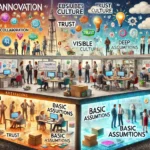Have you ever wondered why some colleagues are always energetic and focused, while others seem to work reluctantly? Or why one person stays late working on projects while another is eagerly waiting for the end-of-day bell?
The answer lies in a crucial concept in organizational behavior: Motivation.
Motivation is like fuel—it drives people to take action, make decisions, and pursue their goals. In organizations, understanding and managing motivation is one of the key factors in achieving success. Let’s dive deeper into this topic together.
What is Motivation?
Motivation is the internal or external force that drives an individual to strive for a specific goal.
- When we are motivated, our energy and focus increase.
- When we lack motivation, even the simplest tasks feel overwhelming.
In the workplace, motivation can be the difference between an average team and an outstanding one.
Types of Motivation
1. Intrinsic Motivation:
This type of motivation comes from within the individual—it’s when we do something because we enjoy it or find it meaningful.
- Example: A graphic designer spends hours working on a design simply because they love creativity and beauty.
2. Extrinsic Motivation:
Here, motivation comes from external factors such as rewards or fear of punishment.
- Example: An employee works overtime to receive a higher bonus.
Why is Motivation So Important?
- Increased Productivity:
Motivated employees complete tasks faster and with higher quality.- They are ready for any challenge and go the extra mile.
- Job Satisfaction:
Motivation is directly linked to job satisfaction.- When we feel our work matters and contributes to a goal, we enjoy it more.
- Improved Team Dynamics:
Motivated individuals uplift the entire team’s spirit.- They inspire their colleagues and spread positive energy.
- Employee Retention:
Motivated employees are more loyal to the organization and less likely to leave.
Factors That Influence Motivation
1. Needs and Desires:
Theories like Maslow’s Hierarchy of Needs suggest that motivation starts with fulfilling basic needs.
- Once primary needs like fair pay are met, employees seek things like respect and self-actualization.
2. Clear Goals:
Having a clear and meaningful goal increases motivation.
- A project with a well-defined objective engages employees more.
3. Feedback:
Regular and constructive feedback helps employees understand their impact.
- A simple “Well done!” can boost motivation significantly.
4. Rewards:
Financial and non-financial incentives are powerful external motivators.
- Examples include salary increases, promotions, or even a thank-you card.
5. Organizational Culture:
A workplace that values growth, respect, and collaboration fosters motivation.
Challenges in Creating Motivation in Organizations
1. Individual Differences:
Everyone is different, and what motivates one person might not work for another.
- Solution: Understand each individual’s needs and motivations.
2. Environmental Issues:
Poor working conditions, excessive pressure, or lack of support can decrease motivation.
- Solution: Create a supportive and balanced environment.
3. Lack of Feedback:
When employees don’t know how valuable their work is, their motivation drops.
- Solution: Provide regular and positive feedback.
How to Boost Motivation?
1. Understand Employee Needs and Values:
Talk to employees and understand what matters to them.
- Some may prioritize career growth, while others value flexibility.
2. Create a Sense of Meaning:
Show employees how their work contributes to the organization’s success.
- When people see the impact of their efforts, they become more motivated.
3. Offer Fair and Diverse Rewards:
Rewards aren’t just about money; sometimes, a simple “thank you” or a learning opportunity is enough.
4. Provide Growth and Learning Opportunities:
Employees who feel they are growing professionally are more motivated.
5. Strengthen Team Interactions:
Create an environment where collaboration and teamwork are encouraged.
- Working together can significantly boost motivation.
A Real-World Example of Motivation’s Impact
A technology company noticed one of its teams had low productivity.
- The team manager started talking to employees and realized they felt unappreciated.
- The manager began giving positive feedback and emphasizing each person’s role in the team’s success.
- The result? Team motivation soared, and productivity increased significantly.
Motivation is the heartbeat of individual behavior in organizations. When we learn how to cultivate it, we don’t just build successful teams—we create a more positive workplace.
What do you think has the biggest impact on motivation? Let’s talk about it. 😊










